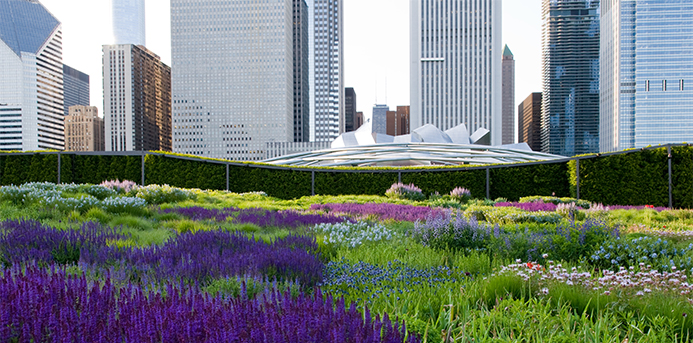Ready to show Mother Earth a little love but not sure how? Fear not. We found a few trailblazers for whom Earth Day is an everyday affair. Try following in their footsteps (baby steps count too) and help make earth a healthier place for generations to come.
1. Stroll an Urban Garden
One need go no further than the Lurie Garden in Millennium Park to get a taste of nature in the heart of Chicago. Approximately 30 percent native plants populate the garden. “By mixing natives and non-natives, we broaden the amount of pollinators we can bring to the garden,” says Scott Stewart, director and head horticulturalist at the Lurie Garden. “The garden is a showpiece that demonstrates to visitors the value of green space.” Not only is it a great place to stroll, but the garden provides countless examples of both beautiful and low-maintenance plants that would thrive in the home garden.
2. Learn, Cultivate, Eat
No gardening know-how, no problem. The Peterson Garden Project (PGP) loves the “grewbie,” their term for a gardening neophyte. PGP founder LaManda Joy’s focus has been on that of the long-term gardener. Her Pop-up Victory Gardens are meant to teach Chicagoans how to grow and cook organic food using sustainable, earth-friendly practices. The group sets up shop on vacant lots throughout the city and transforms these spaces into vibrant raised gardens that remain for several years before they relocate to other neighborhoods. The $85 sign-up fee includes education, some supplies and a 4 x 8 plot in one of the gardens.
3. Know Before You Grow
Take the guesswork out of what to plant. Chicagoland Grows is a plant introduction program that evaluates the performance of trees, shrubs, perennials and grasses to determine their viability in the Upper Midwest. Their plant introduction program is a joint effort between the Chicago Botanic Garden, The Morton Arboretum and the Ornamental Growers Association of Northern Illinois. It’s a great resource for choosing hardy landscape plants for the Chicago area. By using plants with a proven track record, you lessen the need for chemical intervention to keep them alive.
4. Love Thy Bee
What do the Varro mite, deformed wing virus and pesticides have in common? They all contribute to the demise of the honeybee. According to the U.S. Department of Agriculture, 42.1 percent of all bee colonies from April 2014 through April 2015 were lost. The Chicago Honey Co-Op is doing its part to educate the community with their 501c3 charitable, educational nonprofit. In addition to keeping bees and providing honey to area farmers’ markets, the co-op offers a variety of classes, including beginner bee-keeping. “We’ve filled every class since we began teaching,” says Michael S. Thompson, farm manager and one of the founders of the organization. “It’s become more popular because of the growing awareness of environmental issues and the importance of our pollinators.”
5. Start a Rain Collection
According to Aquascape, a one-inch rainfall on a 2,000-square-foot roof displaces 1,250 gallons of water. That water overwhelms storm drains and retention ponds, but it could do so much more. Aquascape’s RainXchange system redirects water into an underground rain-harvesting reservoir that can be used to supply a beautiful water feature in the landscape. In addition to drawing birds and other wildlife, the system provides water for tasks like irrigating flowers and lawns, washing cars and topping off pools — without tapping into the water supply.
6. Smell the Roses
Roses have a bad rap. They’re notorious for being high maintenance, which means plenty of chemical applications to thwart common ailments like black spot. Beauty is as beauty does, but improvements in hybridization have led to some outstanding new roses that require little in the way of chemicals or TLC. “We’ve been consistently working toward more disease resistance,” says Karen Kemp-Docksteader, sales and marketing manager at Weeks Roses. “From my own experience, I don’t spray at all other than to fertilize. It’s all in the breeding and selection.” The company’s Easy to Love Series is a rosarian’s dream. To make the cut, roses must endure a six-year evaluation period in which no insecticides or fungicides are applied.
7. Green is BIG
Kids are into going green and the admissions office at the Chicago High School for Agricultural Sciences has proof. Of the 3,000 applications received last year, only 180 kids were accepted. The school takes a hands-on approach to sustainable farming that far surpasses that of most schools in the country. In fact, it’s the only high school of its kind in the Midwest. The campus is home to a fully functioning farm, a greenhouse, an aquaponics system for tilapia, and the students raise their own beef. “Urban farming is huge,” says Brittney Kee, the school’s horticulture teacher. “It’s an amazing program that takes kids outside the classroom and gives them real-life skills.”
More from Make It Better:

